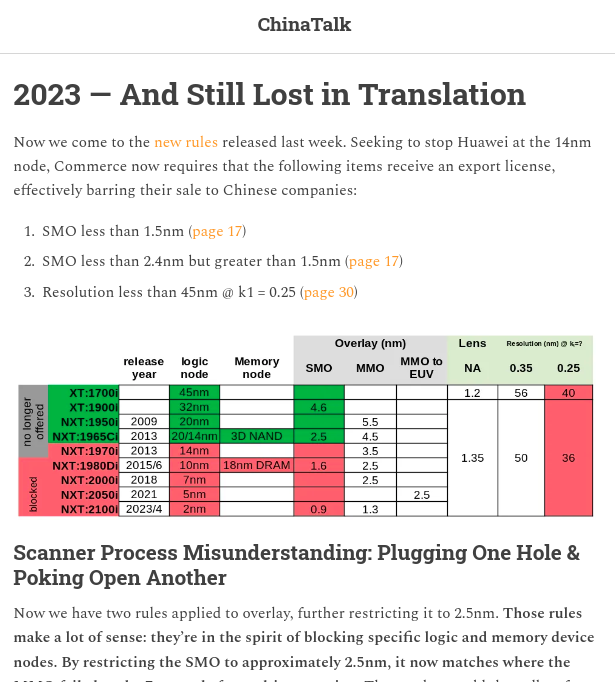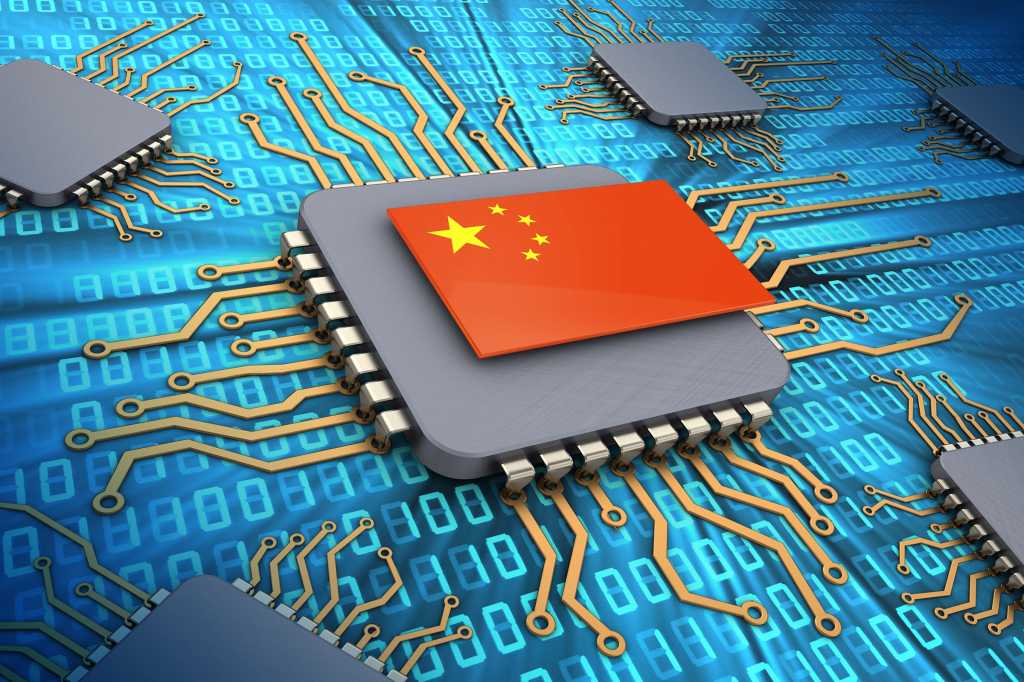Mandatory Reading:
Before student loan forgiveness, the raid on Mar-a-Lago, and the Inflation Reduction Act, something called the CHIPS Act was a major news story for a few days in late July. CHIPS was essentially a bill to support semiconductor manufacturing in the United States, and the final version that passed...

americanaffairsjournal.org
By
Julius Krein
Before student loan forgiveness, the raid on Mar-a-Lago, and the Inflation Reduction Act, something called the CHIPS Act was a major news story for a few days in late July. CHIPS was essentially a bill to support semiconductor manufacturing in the United States, and the final version that passed into law, which added basic research funding and related programs, was christened the CHIPS and Science Act.
By some accounts, CHIPS is a critical tool in the intensifying economic and technological competition against China, a solution to address America’s eroding technological leadership and the decline of a key manufacturing sector. Others still argue that it represents America’s abandonment of free market capitalism. In reality, however, it is neither. More semiconductor fabs will be built in the United States as a result of CHIPS (some commitments have already been announced), but its legislative trajectory also reveals the shortcomings of the current U.S. approach to industrial policy and the lack of any serious resolve when it comes to competing against China.
By way of background, although the United States still leads in key elements of semiconductor design, its share of global manufacturing has fallen from nearly 40 percent in the 1990s to around 10 percent today. Moreover, the chips that are produced in the United States are not at the technological frontier. Taiwan, Korea, and China are the top global producers, with Taiwan’s TSMC the technological leader. China has invested heavily in building its own semiconductor industry since the early 2000s, when it essentially started from zero. While it remains far from technological leadership, it has established a strong
presence at the lower end of the value chain. Moving up the technological ladder remains a major priority for the Chinese government; Beijing’s spending on the sector dwarfs that of the United States, even after CHIPS.
The path of CHIPS itself was a long and winding one. It began as two bills in 2020, both led by Republicans with bipartisan support, that were folded into one: the CHIPS for America Act. CHIPS for America was passed into law via the National Defense Authorization Act in December 2020, but Congress still needed to appropriate funding before it could be implemented. Hence CHIPS funding became a key component of two larger bills, the United States Innovation and Competition Act, or usica (in the Senate), and the America competes Act (in the House). These bills combined CHIPS funding with various research spending and industrial policy programs (mostly drawn from yet another proposal, the Endless Frontiers Act). As with any major piece of legislation nowadays, both also contained their share of pork and extraneous provisions; usica—perhaps ironically for a bill touted as essential to competing with China—additionally included significant tariff relief on Chinese imports. Both bills passed their respective chambers and headed to conference committee, where they languished for months, with no compromise bill that could pass both houses emerging. This is where the story becomes interesting.
There are basically two industry lobbies in the United States interested in CHIPS, in particular, and industrial policy more generally: the Semiconductor Industry Association (SIA), naturally, and a gaggle of groups that lobby on behalf of American universities to promote research funding. Other industries that might presumably have an interest in industrial strategy—such as aerospace, defense, and pharma—are entrenched within their own silos and, if anything, tend to oppose any “innovation” policy that might disrupt the status quo in their verticals. CHIPS was the pet project, and in many ways the brainchild, of SIA from the beginning.
SIA’s attitude toward the broader industrial policy proposals of the larger usica and competes bills was always somewhere between indifference and hostility—which is understandable in the near term but, as we shall see, may prove unfortunate in the longer term. Thus, as the usica–competes conference negotiations dragged on, SIA lobbied aggressively to remove these additional proposals—some dubious, and some, like “
Manufacturing Investment Companies,” much more interesting—and pass a “skinny bill” focused on semiconductor funding alone.
After CHIPS had been isolated from the rest of usica–competes, and essentially reduced to subsidies for incumbent firms, SIA then launched a scorched-earth campaign aimed at removing any restrictions on these subsidies. First, progressives like Bernie Sanders sought to limit firms receiving subsidies from engaging in share buybacks and cash distributions to shareholders. This effort never stood much of a chance in today’s America and was defeated easily. A somewhat more serious challenge came from senators, primarily Republicans, seeking to restrict beneficiary firms’ ability to continue investing in China.
A late addition to the bill allowed the secretary of commerce to grant exemptions from the law’s prohibitions on recipient firms investing in manufacturing facilities in China. This may seem like a minor technical detail to those unfamiliar with multinational firms’ strategies to circumvent trade laws, but allowing the Department of Commerce to grant exemptions has become a common industry tactic to vitiate statutory restrictions. Indeed, the
Wall Street Journal recently
reported that a “Commerce Department–led process that reviews U.S. tech exports to China approves almost all requests and has overseen an increase in sales of some particularly important technologies.” Of course, selling the chips themselves to China is defensible insofar as it keeps Chinese industry dependent on U.S. exports. But investing in production facilities in China is another matter entirely, and this “loophole” arguably undermines a major premise of the whole bill. Several Republican sponsors of the original CHIPS legislation in 2020, including Senators Cotton, Rubio, and Hawley, ended up voting against the 2022 bill as a result.
But by this point, it didn’t matter. The industry’s brazen and in many ways dishonest
lobbying tactics foreclosed any opportunity to correct this loophole. The usual chorus of “national security experts” was trotted out to insist that the bill was essential to compete against China—though on the question of beneficiary firms continuing to invest in China, these experts apparently had nothing to say. Intel threatened to cancel a previously announced investment in an Ohio fab, and the SIA threatened that investment would flow elsewhere if the bill suffered even the slightest delay. In reality, these blackmail attempts were risible—firms would still accept subsidies to invest in the United States even with tighter restrictions on Chinese facilities, and they will continue to invest elsewhere if the subsidies in those countries are sufficient, especially since the bill’s restrictions are so weak—but most congressional offices showed little willingness or capacity to seriously investigate these issues.
The bill’s provisions for research funding went through a similar process. After the university lobbies succeeded in getting various research programs reattached to CHIPS, Senator Rob Portman offered an amendment intended to protect research and intellectual property from Chinese theft and espionage. Despite assurances from Senate leadership, the amendment was unexpectedly
killed, demonstrating once again the lack of any real interest in competing with China.
What, then, is one to make of CHIPS? No single, overarching narrative can be constructed out of its messy evolution, but a few conclusions can be drawn.
First, the recent intellectual ferment around industrial policy in the United States, on both right and left, had minimal impact on this legislation. Provisions with strong corporate lobby support—from either semiconductors or universities—passed; everything else died.
Going forward, more ambitious—and arguably more serious—industrial policies will likely be more difficult to enact, given that the major lobbies have already gotten what they wanted, and because of the bad feeling CHIPS has created among many in Congress. The SIA and university lobbies’ slash-and-burn tactics made clear that they have no interest in any serious industrial strategy or concerted effort to compete with China. Any future initiatives along these lines, however genuine, will now have to overcome the negative presumptions these lobbies have created.
Yet without more robust support for domestic manufacturing outside of semiconductors, any cutting-edge intellectual property resulting from the new research funding can be expected to make its way to Asian factories for production, as has been the
norm for decades now. Other initiatives, like “regional innovation hubs,” deprived of the healthy manufacturing ecosystems that might have been supported by Manufacturing Investment Companies and similar programs, will probably generate more bureaucratic make-work than anything else.
More broadly, although economic and technological competition with China may offer effective political cover in today’s environment, it is clearly not a serious goal of U.S. policy. In light of Congress’s refusal to maintain strict limits on investment in Chinese semiconductor manufacturing facilities or protections on research funding, the recent symbolic controversies over Taiwan (like Nancy Pelosi’s visit) appear all the more bizarre. Likewise, conservative talk of “dismantling the administrative state” and returning power to Congress has once again proved totally fatuous. When presented with an easy opportunity to defend its prerogatives in setting conditions on industrial subsidies, Congress fell over itself to cede authority to the Department of Commerce.
On the other hand, multiple new semiconductor fabs will be built in the United States as a result of CHIPS. This is a real benefit, both for the domestic supply chains they strengthen and the jobs they create. Nevertheless, these projects—still a generation or two behind the most advanced facilities—cannot be expected to catapult America back into the technological lead in semiconductor manufacturing. In fact, within days of CHIPS’s passage, Intel actually
cut capital spending plans.
Over the long term, because semiconductor manufacturing is inherently cyclical, and new fabs in America and doubtless subsidized investments elsewhere will produce occasional gluts, American manufacturing may be especially vulnerable. CHIPS adds to semiconductor supply, but the standalone final version of the bill does nothing to support the reshoring of downstream electronics manufacturers that would provide a domestic source of demand for these chips. Everything does not have to happen in the same bill, of course, but it is very much an open question whether anything along these lines will happen at all. At bottom, the fact that China has built such a massive electronics manufacturing industry underlies the competitive dynamics surrounding chips (and CHIPS) in the first place. Western chipmakers need to sell to Chinese electronics manufacturers, while China seeks greater self-sufficiency in semiconductors in order to protect these other manufacturing industries.
The next key policy question involves the funding guidance that will be issued by the Department of Commerce—i.e., the application process to receive funds. This will provide a good indication of whether Commerce intends to deter investment in China with any rigor. As some observers have
argued, the most important effect of CHIPS may be to limit Korean firms’ investments in China, as these firms seek to preserve eligibility for U.S. subsidies. But this will depend on how rigorously Commerce enforces any restrictions against Chinese investment. Commerce’s prior history, and the fact that industry pushed so hard to allow the department to waive restrictions, are certainly causes for concern.
Taking the long view, CHIPS might have been a great policy solution twenty-five years ago, but amid the current American postindustrial landscape, it is probably too little, too late, on its own. Fallen national champions like Intel, Boeing, GE, IBM, and the like have been hollowed out by decades of financialization, offshoring, and underinvestment; CHIPS or similar subsidies will not fix that. In this sense, criticisms that CHIPS, especially as it ended up, is merely corporate welfare for Intel are probably not inaccurate.
Even so, the libertarian preference for doing nothing remains the least defensible approach, if not downright idiotic. The only thing worse than having second-tier domestic semiconductor manufacturing is having none at all. And since the competitors to American firms are not exactly exemplars of state nonintervention, becoming even more dependent on foreign manufacturing would hardly represent a triumph of the “market.”
Rather than a choice between “corporate welfare” or nothing, what is required are policies—in the areas of finance, intellectual property, trade, and beyond—that would mobilize both state and private capital (especially private equity) behind investment in new domestic production technologies and ecosystems. The Manufacturing Investment Companies, lost in the CHIPS legislation, were a step in this direction, as were, for example, various proposals included in the failed Small Business Administration reauthorization bill in the previous Congress. But America lacks the political will—or, more realistically, an effective corporate lobby—to support such initiatives.
Ironically, when it comes to semiconductor manufacturing, the United States and China find themselves in somewhat similar positions. Both lag industry leaders Taiwan and South Korea, and both are reliant on sclerotic, mostly underperforming national champions. America has not been able to leverage its leadership in certain design technologies to strengthen its hollowed out manufacturing sector, while China’s massive spending has failed to overcome technological barriers—especially compared to its extraordinary successes in sectors such as electric vehicles, batteries, and their supply chains, other manufacturing verticals, and advanced technologies such as AI. Yet China recently
initiated “disciplinary reviews” of the heads of its major chip companies and investment funds, suggesting that the Chinese Communist Party, unlike the U.S. government, is capable of employing both carrots and sticks in its peculiar fashion. Moreover, China, whatever its other problems, has shown an impressive ability to experiment with new
funding models for strategic sectors. In the United States, by contrast, industry has merely shifted from demanding trade support as it pursued offshoring and share buybacks to demanding largely unconditional subsidization.
Former Treasury secretary Lawrence Summers, remarking on the eleventh-hour legislative maneuvering that surrounded the Inflation Reduction Act, passed shortly after CHIPS,
said, “I am appalled by the end stages of the Senate’s bill passage. There is no legitimate public policy argument for the maintenance of carried interested or . . . private equity carve out from the bill. It makes me despair of the general interest above the special interest.” This sentiment may seem a bit rich coming from Summers, who was a leading architect of the financialized political economy that led us to this point, but it is accurate, and it is perhaps an even more appropriate criticism of the end stages of CHIPS. (And the Inflation Reduction Act went quite far in supporting domestic production.) The weakening of investment protections in CHIPS and the defeat of the Portman amendment’s intellectual property protections not only had no public policy justification, but undermined a cardinal purpose of the underlying bill. Real benefits will still result from the CHIPS Act, but on the whole, it looks less like an economic policy success and more like a political disappointment.
This article is an American Affairs online exclusive, published August 30, 2022.









